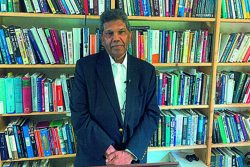On Monday, Emancipation day, I stood on a relative’s veranda in Hopetown watching a group of young and not so young people making their way home, through the rain, after a night of frolic at the annual ‘swari’. I wondered how many of them knew, remembered or cared that they were celebrating the fact that 178 years ago the British parliament passed the Act of Emancipation but because the ensuing four years were more “the last stage of slavery rather than the first stage of freedom”, real emancipation day is regarded as August 1,1838 when ‘full freedom’ came. I also wondered whether they were aware that we were two thirds through the Year for People of African Descent. That the year 2011 had been so designated by the United Nations because as the people most discriminated against, it was hoped the year would stimulate national actions and regional and international cooperation so that people of African descent could enjoy full economic, social, civil and political rights and it would also be used to promote a greater knowledge of and respect for our diverse heritage and culture.
 In Guyana, there is the continued debate as to whether Guyanese of African descent are or have been discriminated against in recent years. Additionally, there is the perception that Guyanese of African descent show little economic/financial finesse, but what our ancestors did in the years after apprenticeship gives the lie to that perception. In the last Sunday Stabroek Editorial it was stated: “Towards the end of the slavery period with the prospect of emancipation shimmering on the horizon, they [the slaves] methodically saved money. They were not allowed to be paid in specie or have it in their possession, so they assiduously saved the small coins they earned during apprenticeship and probably before”. This article briefly elaborates on what they did with those ‘small coins’ and why as detailed in Alan Young’s The Approaches to Local Self-Government in British Guiana.
In Guyana, there is the continued debate as to whether Guyanese of African descent are or have been discriminated against in recent years. Additionally, there is the perception that Guyanese of African descent show little economic/financial finesse, but what our ancestors did in the years after apprenticeship gives the lie to that perception. In the last Sunday Stabroek Editorial it was stated: “Towards the end of the slavery period with the prospect of emancipation shimmering on the horizon, they [the slaves] methodically saved money. They were not allowed to be paid in specie or have it in their possession, so they assiduously saved the small coins they earned during apprenticeship and probably before”. This article briefly elaborates on what they did with those ‘small coins’ and why as detailed in Alan Young’s The Approaches to Local Self-Government in British Guiana.
In British Guiana, the dominant planter class felt that because of the availability of Crown land and abandoned estates, when apprenticeship ended the ex apprentices would abandon the sugar estates which would lead to a labour shortage, the collapse of the sugar economy and by implication, the end of ‘civilised society.’ To forestall this eventuality, the planters used their control over the political institutions of the colony to put in place measures that would keep the apprentices landless and to restrict the freedom of movement of the soon to be ex apprentices. Not all of the planters agreed with that policy. The shrewder amongst them recognized that if the ex apprentices could live on land on or near the plantations, enough to satisfy their desire for a home and help feed their families but not enough to grow a surplus to earn money to provide the other necessities, they would have to continue to work on the nearby plantation.
By the end of 1839 about 267 cottages had been constructed by the apprentices on plots of land half to one third of an acre in size they had purchased. They continued to work on the estates. A planter Carberry, realized the income-earning potential of the phenomenon and cashed in on it. In 1840, he purchased three adjoining estates on the Essequibo coast, Dageraad, Mocha and Westfield and created a small town. He put in streets, divided their front lands into half acre lots which he sold for $100, $150 and $220 each depending on their location in the town. These sold like the proverbial hotcakes. On September 25 1841, at the request of the villagers, it was christened, Queenstown, by Governor Sir Henry Light. This was the beginning of the Proprietary village system under which each villager was given title to his individual plot of land. This initial success led other planters to follow suit. By the end of 1841, about 18 plantations were offering land for sale or lease on the Essequibo coast and the practice soon spread to the counties of Demerara and Berbice. These plots were being sold at Providence, Craig, Supply and Brickery on the east bank of the Demerara river at Sans Souci and Studley Park at Canal No. 1, on the West Bank and Den Amstel, Good Hope and Ruby on the West Bank of the Demerara river. In Berbice the ex apprentices bought plots at Sisters, Cumberland on the Canje and Eliza and Mary at Skeldon.
However, the attitude of the majority of the planters caused the fear of the loss of labour to become a self fulfilling prophecy. After a brief vacation at the end of apprenticeship, most of the now ex apprentices returned to the plantations where they had laboured during slavery and apprenticeship, but they were demanding different conditions of service. For the most part, the men were prepared to continue to work on the estates, but they wanted their wives to stay at home and take care of their families. They also wanted their children to attend the schools which were being set up for that purpose. Additionally, those who had acquired specific skills wanted to negotiate for better wages. This led to confrontations with the planters who refused to accept their former slaves as citizens and free labourers with rights and privileges which went with that status.
As a consequence, many of the ex slaves sought to underscore their status as freemen and their independence from the plantations on which they had endured so much humiliation and suffered so many indignities. They demonstrated this by purchasing some of the 50 mainly cotton estates that had been abandoned. The first such purchase was made on November 2 1839 when 83 labourers from five estates – Dochfour, Ann’s Grove, Hope, Paradise and Enmore together purchased plantation Northbrook for $10,000. Among the purchasers were several women including Maria Grant, Belinda Hopkinson, Catherine Thom, Molly Archer and Hannah Foster. Their initial down payment was $6,000. Much of it was in the form of coins which they had zealously hoarded from their meagre earnings from work during their free time during apprenticeship and from the sale of produce from their provision grounds during slavery. The money was placed in wheelbarrows which they enthusiastically pushed though the streets of Georgetown to where it had to be deposited. The rest of the purchase price was paid off within three weeks.
The new proprietors submitted a petition to Queen Victoria requesting the royal name of Victoria be given to the new plantation village. It was granted. The establishment of Victoria saw the beginning of the establishment of a series of what came to be called communal villages. They were so called because, unlike proprietary villages, the title was vested in the names of several of the more prominent villagers with the understanding that each of the subscribers was entitled to an equal share. By 1840, four communal villages were established in West Coast Berbice. Golden Grove, 500 acres, was purchased by 14 labourers for $1,716; St. John, 252 acres, was purchased by 46 labourers for $5,000; E half of Perseverance, 250 acres, was purchased by 109 labourers for $2,000 and Lichfield, 500 acres, was purchased by one labourer, Cudjoe McPherson for $3,000. He immediately divided it into 12 shares and sold them at a profit. At about the same time, five proprietary villages were established at Zuid Holland, Plegt Anker and Zuid Aan Vleyt on the Canje with Fyrish on the Corentyne coast and Three Sisters on the Berbice River.
This was the first phase of the African village movement. The second phase began in 1842 after a successful strike by the freemen. It was in protest against the attempt by planters in Demerara to implement a series of rules and regulations. This would have significantly reduced their ages. It was during this second phase that Plaisance was purchased by 65 labourers for $39,000 and Ithaca was bought by 45 labourers for $15,000. This second group of purchasers had less money. For example, the initial down payment made for Plaisance was $15,000 and it took the proprietors 18 months to pay it off. It took the proprietors of Ithaca three years to pay off the owner. They did it by working half a day for the owner and half a day for themselves until the price had been paid.
A third phase of the village movement was the result of another, albeit unsuccessful strike in 1848 against the reduction in their wages. On this occasion, the planters had the upper hand. Many of the ex apprentices who had remained on the estates now left but they did not have the disposable income of their predecessors. Many of them went as tenants to the older established villages. This helped to escalate the process of fragmentation that had begun years earlier. By the end of 1848 only about 19,939 labourers remained on the sugar estates while about 44,556 of them lived in the villages.
Today, some 172 years after the establishment of the first village, Guyanese of African descent can look back on that significant achievement and ask ourselves the question: Can we do it again? YES WE CAN, WE MUST.









